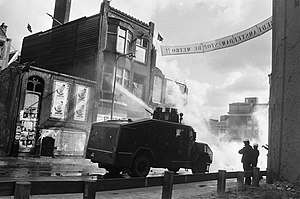Nieuwmarkt riots
The Nieuwmarkt riots (Dutch: Nieuwmarktrellen), also referred to as the Amsterdam metro riots, is a series of serious disturbances in the Nieuwmarkt neighbourhood of Amsterdam, Netherlands. On 24 March 1975, which later became known as Blue Monday,[1] and on 8 April 1975, protests against the planned demolition of homes ended in confrontations with over a hundred municipal police supported by 500 military police.[2] The homes were considered by residents and protesters to be in good condition, but had to make way for the construction of the East Line tunnel of the Amsterdam metro.[3] This was needed because the construction of the 3.5 km tunnel was largely done by sinking large concrete caissons. As a result of the riots, the city council of Amsterdam decided to abandon further plans for additional metro lines.
| Nieuwmarkt riots | |||
|---|---|---|---|
 Nieuwmarkt Riots on 24 March 1975 | |||
| Date | 24 March 1975 - 8 April 1975 | ||
| Location | |||
| Caused by | Construction of the Amsterdam Metro | ||
| Methods | Rioting, protests, barricades | ||
| Resulted in | Future plans for additional metro lines are abandoned | ||
| Parties to the civil conflict | |||
| |||
In 1980, the Nieuwmarkt metro station was opened. It is decorated with artworks that memorialize the turbulent times.[4]
See also
- Vondelstraat riots
- Amsterdam coronation riots
References
- Christopher Catling (1 June 2003). Travellers Amsterdam. Thomas Cook Publishing. ISBN 978-1-84157-261-1.
- Verstraete, Ginette (2013), "Underground Visions:: Strategies of Resistance along the Amsterdam Metro Lines", Paris-Amsterdam Underground, Essays on Cultural Resistance, Subversion, and Diversion, Amsterdam University Press: 77–96, ISBN 9789089645050, JSTOR j.ctt6wp6td.10
- "Civil unrest: Nieuwmarkt ABC". City Archives of Amsterdam. Archived from the original on 2013-02-22. Retrieved 2014-07-31.
- Susan S. Fainstein (22 July 2010). The Just City. Cornell University Press. pp. 146–. ISBN 978-0-8014-6218-4.